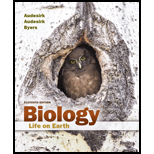
Concept explainers
Which of the following groups contains radially symmetrical organisms?
arthropods
cnidarians
mollusks
roundworms
Introduction:
Body symmetry was not evident in the earlier eukaryotes. It is noted down when tissues were developed in the animals. There are various types of body symmetry. In radial body symmetry, any plane going through the central axis divides the organism into equal halves. In bilateral symmetry, animals can be divided into almost mirror-image halves only among one particular plane through central axis.
Answer to Problem 1MC
Correct answer:
Radially symmetrical organisms are found in cnidarians group among the given groups.
Explanation of Solution
Explanation for the correct answer:
Option (b) is given that radially symmetrical organisms are found in cnidarians. The body plan of cnidarians is unique as any plane passing through their central axis divides these animals into equal halves. This property makes cnidarians different from the organisms evolved before them. Hence, option (b) is a correct answer.
Explanation for incorrect answers:
Option (a) is given that radially symmetrical organisms are found in arthropods. Arthropods are bilaterally symmetrical organisms as there is only one plane that passes through the central axis that can divide them into mirror-image halves. So, it is an incorrect option.
Option (c) is given that radially symmetrical organisms are found in molluscs. Molluscs are bilaterally symmetrical organisms as there is only one plane that passes through the central axis that can divide them into mirror-image halves. So, it is an incorrect option.
Option (d) is given that roundworm possesses radial symmetry. Roundworms are bilaterally symmetrical organisms as there is only one plane that passes through the central axis that can divide them into mirror-image halves. So, it is an incorrect option.
Hence, options (a), (c), and (d) are incorrect.
Therefore, it can be concluded that from the given groups, radially symmetrical organisms are found in cnidarians.
Want to see more full solutions like this?
Chapter 24 Solutions
Biology: Life on Earth Plus Mastering Biology with Pearson eText -- Access Card Package (11th Edition)
- Which of the following does not occur? a. radially symmetrical diploblast b. diploblastic eucoelomate c. protostomic coelomate d. bilaterally symmetrical deuterostomearrow_forwardFrogs belong to which order? Anura Urodela Caudata Apodaarrow_forwardAn animal whose development is marked by radial cleavage and enterocoely is. a deuterostome an annelid or mollusk either an acoelomate or eucoelomate none of the abovearrow_forward
- Which of the following is not a feature common to most animals? a. development into a fixed body plan b. asexual reproduction c. specialized tissues d. heterotrophic nutrient sourcingarrow_forwardWhich of the following is not possible? radially symmetrical diploblast diploblastic eucoelomate protostomic coelomate bilaterally symmetrical deuterostomearrow_forwardWhich of the following has indeterminate development? Echinodermata Nematoda Arthropoda Platyhelminthesarrow_forward
- Which of the following phyla or classes displays the greatest number of species? Question 1 options: Mollusca Nematoda Annelida Insectaarrow_forwardWhich of the following animal groups is triploblastic, has deuterostome development, and has a digestive system, a nervous system, and an excretory system, but does not have a vertebral column? the acoelomate flatworms (like the planaria) the cephalochordates (like the lancelet) the poriferans (like the calcareous sponges) the coelenterates (like the jellyfish) the agnathan fishes (like the sea lamprey)arrow_forwardWhich of the following does NOT occur? radially symmetrical diploblast diploblastic eucoelomate protostomic coelomate bilaterally symmetrical deuterostomearrow_forward
- Which of the following sponge body types would have the lowest amounts of gas exchange and feeding? Synconoid Asconoid Leuconoidarrow_forwardYou take a field trip to tide pools in Puget Sound and encounter all sorts of Animals. Please use the following descriptions of those adult Animals to determine which of the 9 major phyla each belongs. Has radial symmetry and two tissue layers: ["cnidaria", "Mollusca", "Arthropoda", "Annelida", "Platyhelminthes", "Porifera"] Has 6 jointed appendages and a chitinous exoskeleton: ["cnidaria", "Mollusca", "Arthropoda", "Annelida", "Platyhelminthes", "Porifera"] Has bilateral symmetry with a digestive sac and no coelom: ["cnidaria", "Mollusca", "Arthropoda", "Nematoda", "Platyhelminthes", "Porifera"] Has bilateral symmetry, an open circulatory system, a digestive tube, gills and a radula: ["cnidaria", "Mollusca", "Arthropoda", "Nematoda", "Platyhelminthes", "Porifera"] Has no true tissues and no body symmetry: ["cnidaria", "Mollusca", "Arthropoda", "Nematoda", "Platyhelminthes", "Porifera"]arrow_forwardAnimals with calcium-based shells are found in the phylum... Group of answer choices Nematoda Arthropoda Porifera Mollusca Platyhelminthesarrow_forward
 Biology 2eBiologyISBN:9781947172517Author:Matthew Douglas, Jung Choi, Mary Ann ClarkPublisher:OpenStax
Biology 2eBiologyISBN:9781947172517Author:Matthew Douglas, Jung Choi, Mary Ann ClarkPublisher:OpenStax Biology Today and Tomorrow without Physiology (Mi...BiologyISBN:9781305117396Author:Cecie Starr, Christine Evers, Lisa StarrPublisher:Cengage Learning
Biology Today and Tomorrow without Physiology (Mi...BiologyISBN:9781305117396Author:Cecie Starr, Christine Evers, Lisa StarrPublisher:Cengage Learning Concepts of BiologyBiologyISBN:9781938168116Author:Samantha Fowler, Rebecca Roush, James WisePublisher:OpenStax College
Concepts of BiologyBiologyISBN:9781938168116Author:Samantha Fowler, Rebecca Roush, James WisePublisher:OpenStax College


